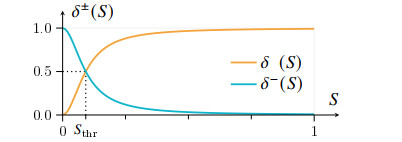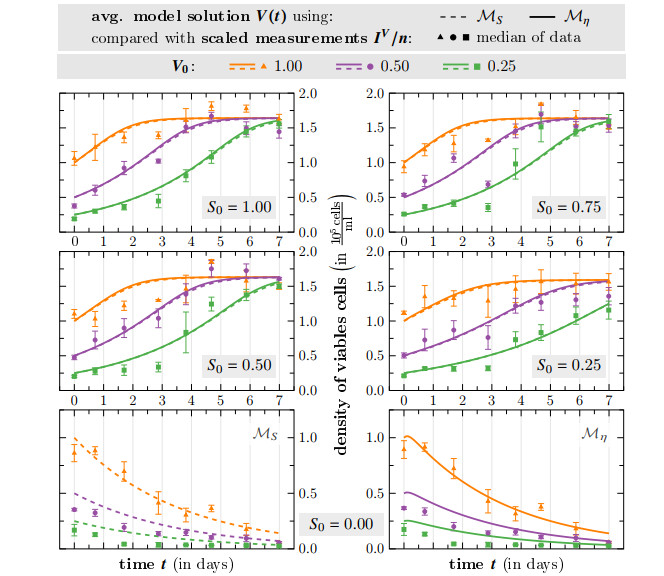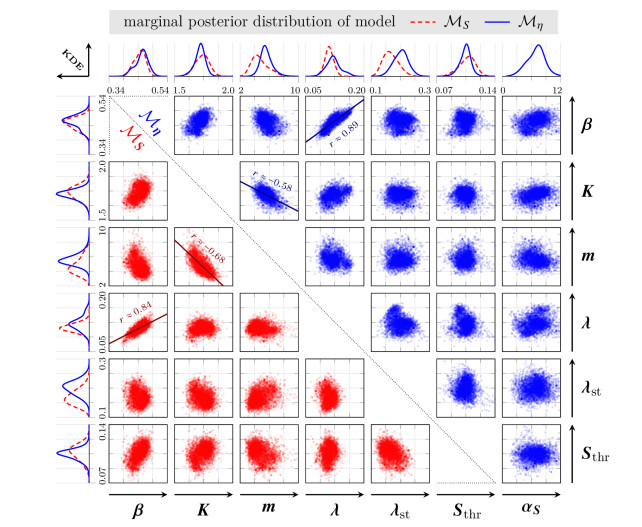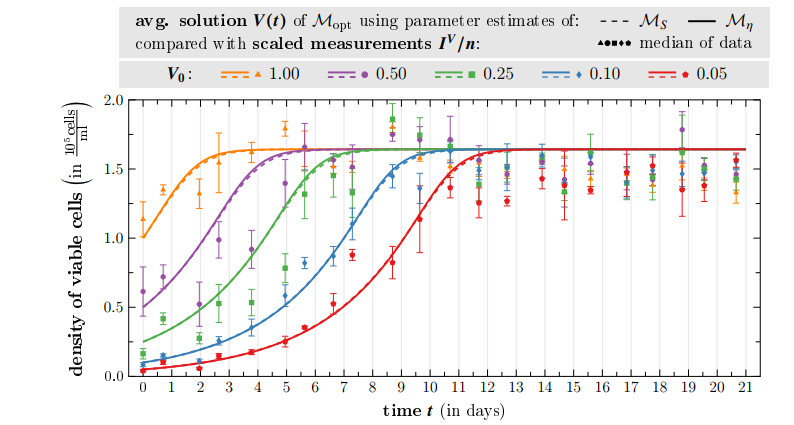1.
Introduction
The Poisson distribution is so important among the discrete distributions. Poisson distribution represents the probability of prescribed number of events arising at a fixed time or space interval as these events happen at a predicted constant mean rate and regardless of time after the last one. It's an occurrence. Also the Poisson distribution in other indicated intervals like time, area or volume can be applicable for series of events. Probability mass function (PMF) of Poisson distribution is given by
Sadooghi-Alvandi [1] considered estimation of the parameter of a Poisson distribution using a linex loss function. Zhang et al. [2] computed empirical Bayes estimators of the parameter of the Poisson distribution under Stein's loss function. Li and Hao [3] computed E-Bayesian and hierarchical Bayesian estimators of Poisson distribution parameter under the entropy loss function.
E-Bayesian estimation was introduced by Han [4] as a simpler method of estimation. Jaheen and Okasha [5] studied E-Bayesian estimate for Burr Type XII model that focuses on type-2 censorship. Karimnezhad et al. [6] considered Bayes, E-Bayes and robust Bayes predicts a potential discovery as a precautionary step Prediction error functions for applications. Gonzalez-Lopez et al. [7] gave the E-Bayesian approximations for device performance and feasible option centered on exponential distribution. The apparatus stability to find parameter dependent on the function with asymmetric loss was proposed by Yousefzadeh [8] for the estimations of E-Bayesian and hierarchical Bayesian. Estimators of E-Bayesian for structural approach based statistical information are obtained by Okasha and Wang [9]. Han [10,12], computed the E-Bayesian estimates for different distributions. Kiapour [13] considered premium estimate and forecast of Bayes, E-Bayes and robust Bayes through square log error loss function. With the help of E-Bayesian method, Okasha [14,15] concerned for calculating estimates for parameters of different distributions for different types of data. Okasha et al. [16] computed E-Bayesian estimators of Burr Type XII distribution based on adaptive Type-II progressive hybrid censored data. Basheer et al. [17] considered E-Bayesian and Hierarchical Bayesian Estimations for the parameter and reliability of the inverse Weibull distribution. E-Bayesian estimates of a simple step stress model for exponential distribution are obtained by Nassar et al. [18]. Athirakrishnan and Abdul-Sathar [19] computed E-Bayesian and hierarchical Bayesian estimates for the scale parameter and reversed hazard rate of inverse Rayleigh distribution. Okasha and Mustafa [20] studied E-Bayesian estimation for Weibull distribution in the case of adaptive Type-I progressive hybrid censored competing risks data.
The empirical Bayesian analysis considers the case when the parameters of the prior distribution are unknown. This implies that the sampling distribution is identified, however the earlier distribution isn't. The marginal distribution in order to retrieve the prior distribution from representative sample is then used. In this case, hyperparameters are estimated from the random sample, then we used to compute the Bayesian estimators. The empirical Bayes method is introduced in Robbins [21,22,23]. Zhang et al. [24] computed the empirical Bayes estimators of the parameters of the normal distribution with a conjugate normal-inverse-gamma prior. Mikulich-Gilbertson et al. [25] used empirical Bayes predictors from generalized linear mixed models to test and visualize associations among longitudinal outcomes. Martin et al. [26] proposed empirical Bayes posterior concentration in sparse high dimensional linear models. Empirical Bayes estimates in exponential reliability model was computed by Sarhan [27]. Chang and Li [28] proposed empirical Bayes decision rule for classification on defective items in Weibull distribution. The role of empirical Bayes methodology in medical statistics is discussed by van Houwelingen [29]. Jaheen [30] derived empirical Bayes estimators for the parameter of the generalized exponential distribution based on record values. In this paper, we extend the idea of empirical estimation to E-Bayesian estimation. We consider the hyperparameters of the prior parameters are unknown. We use the moment method to estimate this parameters using the random sample. In the case of the classical E-Bayesian estimation we treat the hyperparameters as being known, but in practice the hyperparameters are unknown and therefore it is more critical to use empirical E-Bayesian estimation.
2.
Bayesian estimation
Based on a complete sample T1,T2,...,Tn of size n, from Poisson distribution, the likelihood function can be written as
The prior distribution with gamma conjugate for μ, as
From (2.1) and (2.2), the posterior distribution function can be obtained as following
where
In view of squared error loss function, the Bayes estimator of the parameter μ is suggested as
3.
E-Bayesian estimation
According to E-Bayesian method, prior parameters θ and λ ought to be chosen to ensure that π(μ) is a lower bound of μ. The differential of π(μ) is given as
Then the prior distribution π(μ) is decreasing function for λ>0,0<θ<1, for more details see Han [4].
By considering θ and λ are independent parameters with bivariate density function
Therefore, the E-Bayesian estimator of the parameter μ is given by
In this section, E-Bayesian approximation of μ parameter is based on different distributions of θ and λ. The effect of numerous previous distributions on E-Bayesian estimates of μ is explored by these distributions. The distributions of the parameters θ and λ are considered below:
For g1(θ,λ), g2(θ,λ) and g3(θ,λ), the E-Bayesian estimators of the parameter μ are given from (2.5), (3.3) and (3.4), respectively, by
and
3.1. Estimation of E-Bayesian with E-posterior risk
Posterior risk for E-Bayesian approximation was introduced first by Han [31], as follows
where posterior risk R[ˆμB] of Bayesian estimation is given by
From (2.3) and (3.9) we have
where θ∗ and λ∗ as in (2.4).
The E-posterior risk for ˆμEBi(i=1,2,3) from (3.4), (3.8) and (3.10), respectively, are shown by
4.
Characteristics of E-Bayesian estimators for μ
This section explores relationship among ˆμEBi and E−R(ˆμEBi), i=1,2,3.
(A) Relations between ˆμEBi, i=1,2,3
Lemma 1. It leads from (3.5)–(3.7)
(i) ˆμEB3<ˆμEB1<ˆμEB2.
(ii) limn→∞ˆμEB1=limn→∞ˆμEB2=limn→∞ˆμEB3.
Proof. (ⅰ) Eqs (3.5)–(3.7) provide
For −1<y<1, we have ln(1+y)=y−y22+y33−y44+...=∑∞k=1(−1)k−1ykk. Let y=cn, when 0<c<n, 0<cn<1, we have
From (4.1) and (4.2), we have
that is
(ⅱ) From (4.1) and (4.2), we have
That is, limn→∞ˆμEB1=limn→∞ˆμEB2=limn→∞ˆμEB3.
(B) Connections between E−R(ˆμEBi), i=1,2,3
Lemma 2. It follows from (3.11) that
(i) E−R(ˆμEB3)<E−R(ˆμEB1)<E−R(ˆμEB2).
(ii) limn→∞E−R(ˆμEB1)=limn→∞E−R(ˆμEB2)=limn→∞E−R(ˆμEB3).
Proof. (ⅰ) From (3.11), we achieve
For −1<y<1, we have ln(1+y)=y−y22+y33−y44+...=∑∞k=1(−1)k−1ykk. Let y=cn, when 0<c<n, 0<cn<1, we have
Eqs (4.3) and (4.4) imply that
(ⅱ) From (4.3) and (4.4), we have
That is, limn→∞E−R(ˆμEB1)=limn→∞E−R(ˆμEB2)=limn→∞E−R(ˆμEB3). Thus, the proof is complete.
5.
Empirical E-Bayesian estimation
In this section, we introduce empirical E-Bayesian method (EE-Bayesian). In this method, we consider the case when the parameters a, b and c in (3.4) which are used in E-Bayesian estimation are unknown parameters, we use empirical Bayes approach to get their estimates. The marginal PMF of the random variable T is obtained from (1.1) and (2.2) as
Specifically, since θ is a positive integer, marginal distribution of random variable T is a negative binomial distribution, NB(r,p), with parameters
The estimators of the parameters θ and λ are obtained by using the moment method. To obtain the moment estimators of θ and λ, we need to calculate the first two moments of T, E(T) and E(T2). It is easy to show that
Furthermore, the moment estimators can be obtained by equal the population moments with the sample moments as
From (5.3) and (5.4), we obtain the moment estimators of θ and λ, respectively, by
and
where
Also, to obtain moment estimators of parameters a and b in (3.4), we need to calculate E(θ) and E(θ2), which is easy to show that
Then, from (5.8) and applying moment method, we attain moment estimators of parameters a and b, respectively,
and
where
where ˆθm is given by (5.5).
The moment estimators of c for g1(θ,λ), g2(θ,λ) and g3(θ,λ) is given, respectively, by
and
where ˆλm, is given by (5.6).
Then, the EE-Bayesian estimates of the parameter μ for g1(θ,λ), g2(θ,λ) and g3(θ,λ) are given, respectively, by
and
5.1. The empirical E-posterior risk of EE-Bayesian estimation
Empirical E-posterior risk related to estimates of EE-Bayesian ˆμEEBi(i=1,2,3) are given from (3.11), by replacing the parameters a, b and c with their corresponding moment estimators
6.
Simulation in Monte Carlo
In this part, a Monte Carlo modeling is applied for an examination of E-Bayes and EE-Bayesian assessment with the respective projections estimating maximum likelihood.
6.1. E-Bayesian estimation
Here, Monte Carlo simulation is being established to equate the maximum likelihood and E-Bayesian model specification. It calls the following steps:
(ⅰ) We generate θ and λ for specified values of previous parameters (a,b) and (0,c) via beta and uniform priors (3.4), individually.
(ⅱ) Generate μ from gamma density (2.2) for predicted values of θ and λ.
(ⅲ) For known values of μ in step (2), we generate complete sample of Poisson distribution with PMF (1.1).
(ⅳ) Maximum likelihood estimate ˆμML and ˆμEBi, i=1,2,3 are computed based on squared loss function.
(ⅴ) Also we compute E−R(ˆμEBi) from (3.11) where i=1,2,3.
(ⅵ) The output of all results has been analyzed mathematically in three terms with i=1,2,3. First is taken as the average of the estimates ˆμML and ˆμEBi, the second is the estimated risks (ERs) of ˆμML and ˆμEBi, and the third is E-posterior risks E−R(ˆμEBi), i=1,2,3. Repetition 10000 times of above steps, then simulation tests are appeared in Tables 1–3.
6.2. EE-Bayesian estimation
In order to compare maximum likelihood and approximation of EE-Bayesian design, a Monto Carlo technique is enforced. The subsequent measures are noticed.
(ⅰ) We construct θ and λ for the desired value of obtained parameters (a,b) and (0,c) by beta and (3.4), independently.
(ⅱ) Develop μ from gamma calculated density (2.2) for expected values of θ and λ.
(ⅲ) For recognized values of μ in step (2), we generate complete sample of Poisson distribution with PMF (1.1).
(ⅳ) Estimations ˆμML and ˆμEEBi, i=1,2,3 are computed by orienting squared loss function.
(ⅴ) Also we compute EE−R(ˆμEEBi), i=1,2,3 from (5.18).
(ⅵ) The efficiency of all findings was examined statistically in three terms. The first is the average of the estimates ˆμML and ˆμEEBi, the second is the estimated risks (ERs) of ˆμML, ˆμEEBi, and the third is empirical E-posterior risks EE−R(ˆμEEBi), for all i=1,2,3. Simulation runs by repeating 10000 times of above steps are seen in Tables 4–6.
7.
Real data analysis
Information on the quantity of deaths caused by horse kicks in light of the perception of 10 Prussian cavalry corps for a very long time (proportionally, 200 corps-years) in Figure 1 are issued. Prussian authorities gathered this data during the last year of the nineteenth century to consider the perils that horses presented to fighters, (see Bortkiewicz [32]). Padilla [33] discussed the validity of the model for the given real data set and showed that Poisson distribution fits quite well to it.
In the present circumstance, possibilities of death because of a kick from a horse are little while. Although the number of troops exposed to this danger is very high. Hence, a Poisson distribution can well match the results. Then, it is possible to approximate the mean amount of deaths per period as
In this section we consider E-Bayesian and EE-Bayesian estimation for parameter μ.
7.1. E-Bayesian
For the real data that is considered in Figure 1, we obtain E-Bayesian estimates and E-posterior risk for μ. The computational results are recorded in Table 7.
7.2. EE-Bayesian
For the real data that is considered in Figure 1, we obtain EE-Bayesian estimates and EE-posterior risk for the parameter μ. The numerical results are listed in Table 8.
8.
Conclusions
This paper describes E-Bayesian and EE-Bayesian methodology which are considered as to find approximation of unknown parameter of Poisson distribution with complete sample. E-Bayesian and EE-Bayesian estimators are implemented under the function of squared error loss and three hyper-parameter distributions. Also, E-posterior and EE-posterior risks are computed. Some statistical properties of E-Bayesian and E-posterior risk estimates relative to squared error loss function are extracted. Via a simulation analysis, a survey of different estimated parameters is carried out. The simulation results indicate that E-Bayesian and EE-Bayesian methods do very well in the estimation of model parameters under minimal mean square defects. Finally, to follow the E-Bayes and EE-Bayes estimator, one individual data set is scrutinized. It is inferred from the mathematical examination that E-Bayesian and EE-Bayesian estimators operate effectively than classical estimators.
Acknowledgment
This research was funded by the Deanship of Scientific Research at Princess Nourah bint Abdulrahman University through the Fast-track Research Funding Program. My sincere gratitude to my professor Zeinhum F. Jaheen for his support and encouragement during the research.
Conflict of interest
The author declares there are no conflicts of interest in this paper.









 DownLoad:
DownLoad:














